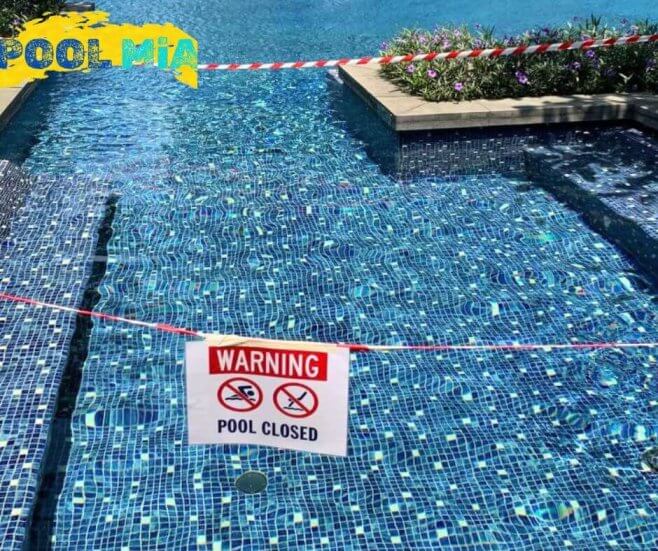Swimming pools are delightful havens for relaxation and recreation, but ensuring a safe environment is paramount. From water quality to chemical usage, maintaining a secure swimming pool requires diligence and awareness. In this comprehensive guide, we’ll delve into essential tips to guarantee a secure splash for everyone.
Water Quality Matters
Routine Testing and Balancing swimming pool water :
To ensure a safe swimming environment, regularly test the water for pH levels, chlorine concentration, and alkalinity. Balancing these factors prevents issues like skin and eye irritation.
pH Levels: Regularly checking pH levels is essential, as imbalances can lead to discomfort for swimmers and potential damage to pool equipment. The ideal pH range is typically between 7.2 and 7.8. If levels are too low, adding a pH increaser is necessary, while a pH reducer is used if levels are too high.
Chlorine Concentration: Monitoring chlorine concentration is vital for effective sanitation. Chlorine kills bacteria and contaminants, keeping the water safe for swimming. Regular testing helps maintain the ideal chlorine level typically between 1 and 3, preventing skin and eye irritation while ensuring efficient disinfection.
Alkalinity Levels: Alkalinity acts as a pH buffer, preventing rapid fluctuations. Testing and adjusting alkalinity levels contribute to overall water stability, enhancing the effectiveness of pH control and minimizing the need for constant adjustments.
Pool Filtration Systems:
Investing in a reliable filtration system is fundamental to maintaining a clean and safe swimming pool. The filtration system serves as the pool’s essential cleansing mechanism, removing debris, dirt, and contaminants from the water. Regular maintenance, including cleaning or replacing filters as needed, is imperative to sustain optimal performance. A well-maintained filtration system not only enhances water clarity but also promotes a healthier swimming environment by preventing the buildup of harmful microorganisms.
Proper Circulation:
Ensuring proper water circulation is paramount for maintaining a healthy and safe swimming pool. An efficient circulation system helps distribute chemicals evenly, preventing localized imbalances. This promotes uniform water quality throughout the pool, reducing the risk of algae growth and bacterial contamination. Regularly inspecting and maintaining the pool’s pumps and filters is essential to guarantee optimal circulation.
Chemical Safety Protocols
Appropriate Chlorine Usage:
While chlorine is vital for pool sanitation, overuse can lead to skin and respiratory issues. Follow recommended guidelines for chlorine application.
- Chemical Storage Safety:
Store swimming pool chemicals in a cool, dry place, away from direct sunlight. Keep them tightly sealed and follow all safety instructions provided by manufacturers.
- Educate Pool Users:
Properly educating pool users is paramount for a safe swimming environment. Clear signage should outline essential rules, such as the importance of showering before entering the pool, avoiding urination in the water, and refraining from eating. This education minimizes the introduction of contaminants, promotes chemical effectiveness, and ensures a hygienic experience for all. By fostering awareness among pool users, a collective commitment to maintaining a clean and safe pool environment is established, contributing to the overall well-being of swimmers and the longevity of the pool infrastructure.
Emergency Preparedness
Every Pool Owner Should Know In 2024 CLICK
- CPR Training:
Ensure that at least one person present at the swimming pool is trained in CPR. Quick responses to emergencies can make a significant difference.
- Life-saving Equipment:
Always have life-saving equipment such as lifebuoys and reaching poles accessible. inspect their condition to guarantee functionality Regular.
- Emergency Contacts:
Display emergency contact information prominently. Include the nearest medical facilities, poison control, and other relevant numbers.
Physical Safety Measures
- Anti-slip Surfaces: Ensure that pool decks and surrounding areas have anti-slip surfaces to prevent accidents caused by slippery conditions.
- Proper Pool Depth Markings: Clearly mark pool depths to prevent diving accidents. Educate swimmers on the importance of adhering to depth guidelines.
Regular Maintenance Routines
- Secure Pool Perimeter: a secure pool fence with a self-locking gate to prevent unauthorized access, especially for homes with children.
- Scheduled Inspections: Routine inspections of pool infrastructure, including ladders, diving boards, and handrails, are paramount for ensuring user safety. These routine checks help identify signs of wear, corrosion, or damage that could compromise the structural integrity of these essential components. Addressing issues promptly ensures that users can enjoy the pool without concerns about the safety of its physical features. By incorporating scheduled inspections into the maintenance routine, pool owners contribute to a secure environment, mitigating potential hazards and enhancing the overall longevity and reliability of the pool facilities.
- Drain Covers: Ensure drain covers are intact and in compliance with safety regulations to prevent entrapment incidents.
- Professional Maintenance: Engaging professional pool maintenance services regularly is a key element in ensuring the longevity, safety, and efficiency of your pool. Experienced professionals possess the expertise to identify and address potential issues before they escalate, from equipment malfunctions to structural concerns. Their thorough inspections cover crucial aspects like filtration systems, pumps, and safety features. Additionally, professionals can provide tailored advice on upgrades, helping you stay current with the latest advancements in pool technology.
By prioritizing water quality, adhering to chemical safety protocols, preparing for emergencies, implementing physical safety measures, and maintaining regular pool upkeep, you can transform your pool into a secure haven for enjoyment. Following these essential tips ensures that your splash is not only refreshing but also safe for all. Stay informed, stay secure, and enjoy your swimming experience to the fullest.

Pingback: 10 Tips How to Prevent Algae Growth in the Swimming Pool
Pingback: 12 Things Every Pool Owner Should Know In 2024 Pool Mia